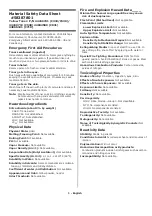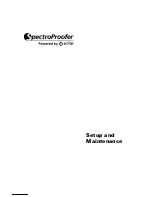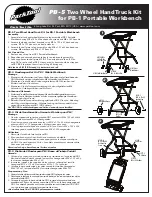
2
ENGLISH
SYMBOLS ON DOLMAR BATTERIES
1.
Do not short batteries.
2.
Always recycle batteries.
3.
Do not discard batteries into garbage can or the like.
4.
Do not expose battery to water or rain.
5.
Do not destroy battery by fire.
Note:
The recycling method may differ from country to country, or state
(province) to state (province). Consult with your nearest Dolmar
Authorized Service Center or Distributor.
[UK only]
In accordance with European Directive 91/157/EEC on batteries
and accumulators containing dangerous substances and UK
Regulations please return your used Dolmar battery to any
Dolmar authorised service center or distributor. Dolmar will then
ensure it is correctly recycled.
Checking the remaining battery capacity
Press the CHECK button to indicate the remaining battery
capacity. The indicator lamp will then light for approx three
seconds.
Example) 45% – 70% indication
Note:
• When only the lowermost indicator lamp (next to the “E”) blinks,
or when none of the indicator lamps light, the battery capacity
has run out and the tool does not operate. In these cases,
charge the battery or replace the empty battery with a fully
charged one.
• When two or more indicator lamps do not light even after charg-
ing is complete, the battery has reached the end of its service
life.
• When the upper two and lower two indicator lamps light alter-
nately, the battery may have malfunctioned. Contact your local
Dolmar Service center to request inspection and/or repair.
• The indicated capacity may be lower than the actual level during
use or immediately after using the tool.
• Depending on the conditions of use and the ambient tem-
perature, the remaining battery capacity may not be displayed
correctly.
Indicator lamps
CHECK button
Lamp indications
Indicator lamps
Remaining charge
: On
: Off
: Blinking
E
F
70% to 100%
45% to 70%
20% to 45%
0% to 20%
Charge the battery.
The battery may have
malfunctioned.
SAVE THESE INSTRUCTIONS
FOR BATTERY CARTRIDGE
1. Before using battery cartridge, read all instructions and
cautionary markings on (1) battery charger, (2) battery, and
(3) product using battery.
2. Do not disassemble battery cartridge.
3. If operating time has become excessively shorter, stop
operating immediately. It may result in a risk of overheating,
possible burns and even an explosion.
4. If electrolyte gets into your eyes, rinse them out with clear
water and seek medical attention right away. It may result in
loss of your eyesight.
5. Do not short the battery cartridge:
(1) Do not touch the terminals with any conductive material.
(2) Avoid storing battery cartridge in a container with other
metal objects such as nails, coins, etc.
(3) Do not expose battery cartridge to water or rain.
A battery short can cause a large current flow, overheating,
possible burns and even a breakdown.
6. Do not store the tool and battery cartridge in locations where
the temperature may reach or exceed 50 °C (122°F).
7. Do not incinerate the battery cartridge even if it is severely
damaged or is completely worn out. The battery cartridge can
explode in a fire.
8. Be careful not to drop or strike battery.
9. Do not use dropped or struck battery.
Battery/charger combinations and charging time
Battery cartridge
Battery charger
LG-3622
AP-3622
Approx. 60 min.
Tips for maintaining maximum battery life
1. Charge the battery cartridge before completely discharged.
Always stop tool operation and charge the battery cartridge
when you notice less tool power.
2. Never recharge a fully charged battery cartridge.
Overcharging shortens the battery service life.
3. Charge the battery cartridge with room temperature at 10 °C
– 40° C (50° F – 104° F).
Let a hot battery cartridge cool down before charging it.
4. Charge the battery cartridge once in every six months if you
do not use it for a long period of time.



































